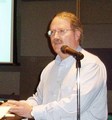LEADING CHANGE IN BRITISH COLUMBIA: “Jim Dumont has played an important role in defining a vision of what can be. His pragmatic contributions to the Water Balance Model mission are rippling through time,” stated Ted van der Gulik, President, when the Partnership for Water Sustainability recognized Jim Dumont as a ‘Champion Supporter’ (Dec 2013)

By 2002, looking at rainfall differently led the Province to adopt the Water Balance Methodology, initiate a performance target approach to capturing rain where it falls, and initiate changes in the ways rainwater runoff is returned to streams. A year later, this led to development of the Water Balance Model as a scenario comparison and decision support tool. “When Jim Dumont joined the WBM team as Engineering Applications Authority in 2005, it was indeed a milestone moment,” stated Ted van der Gulik. “Year after year, his in-kind contributions are consistent, substantial and invaluable,”









